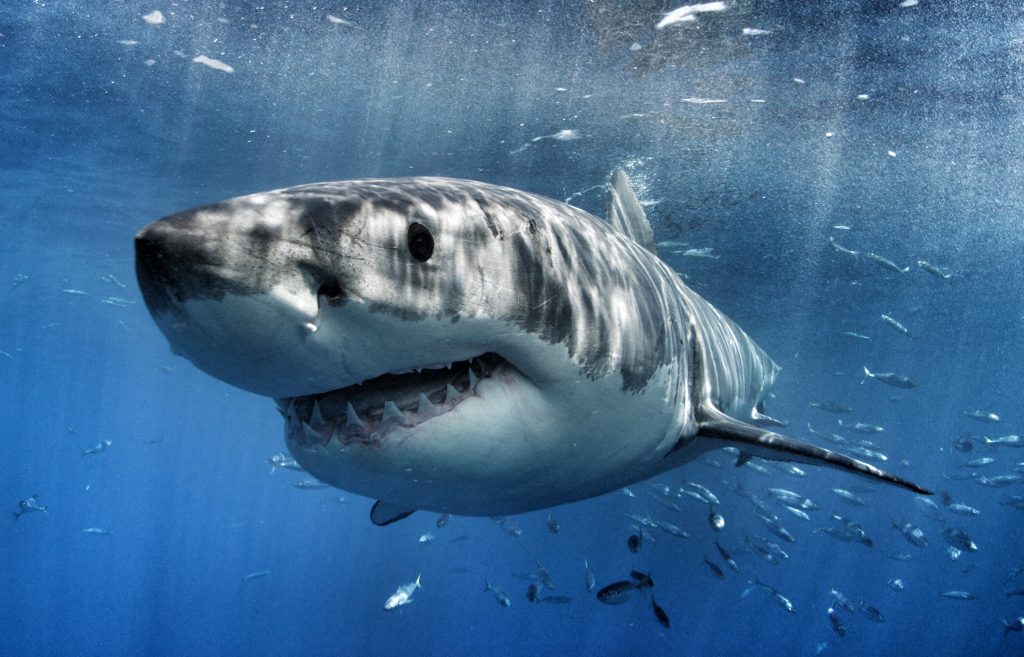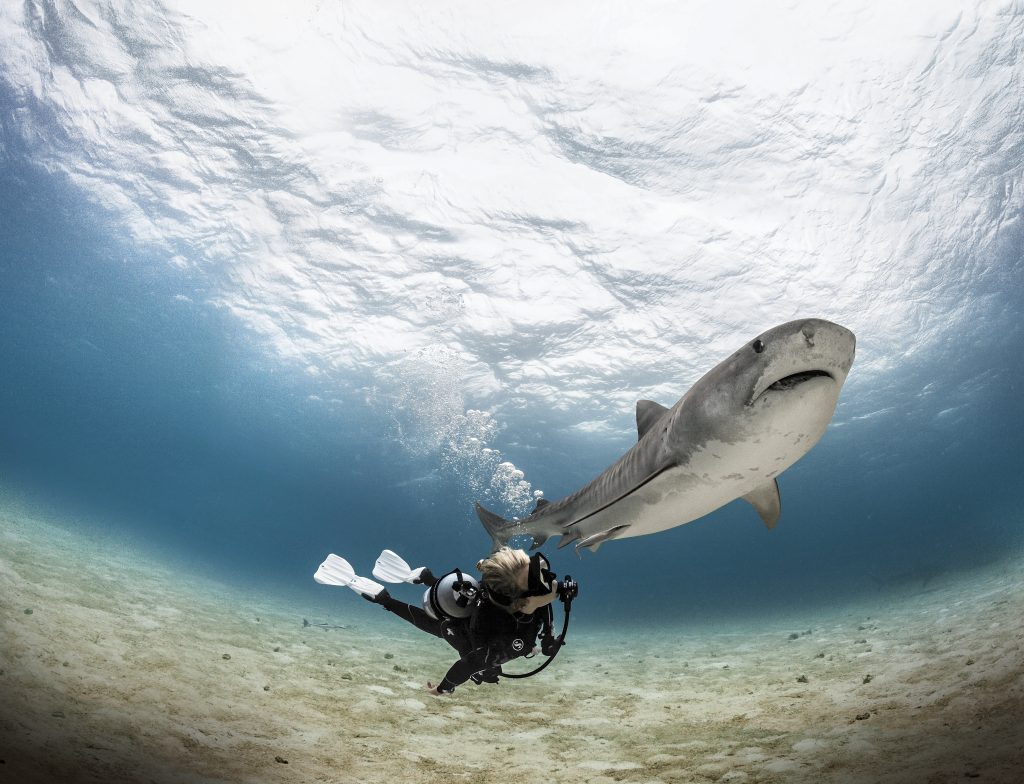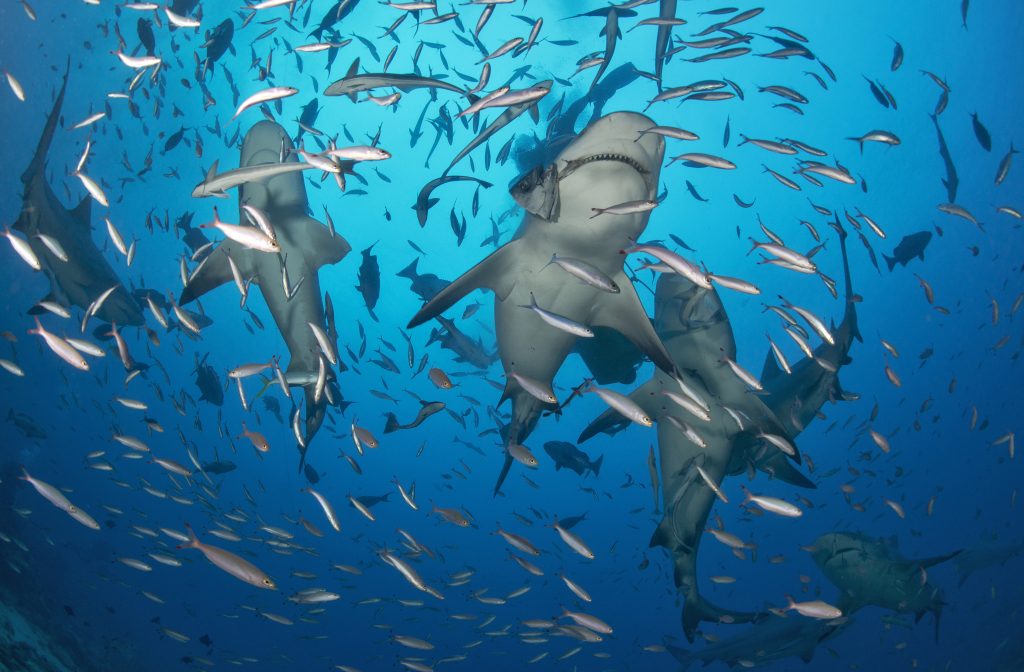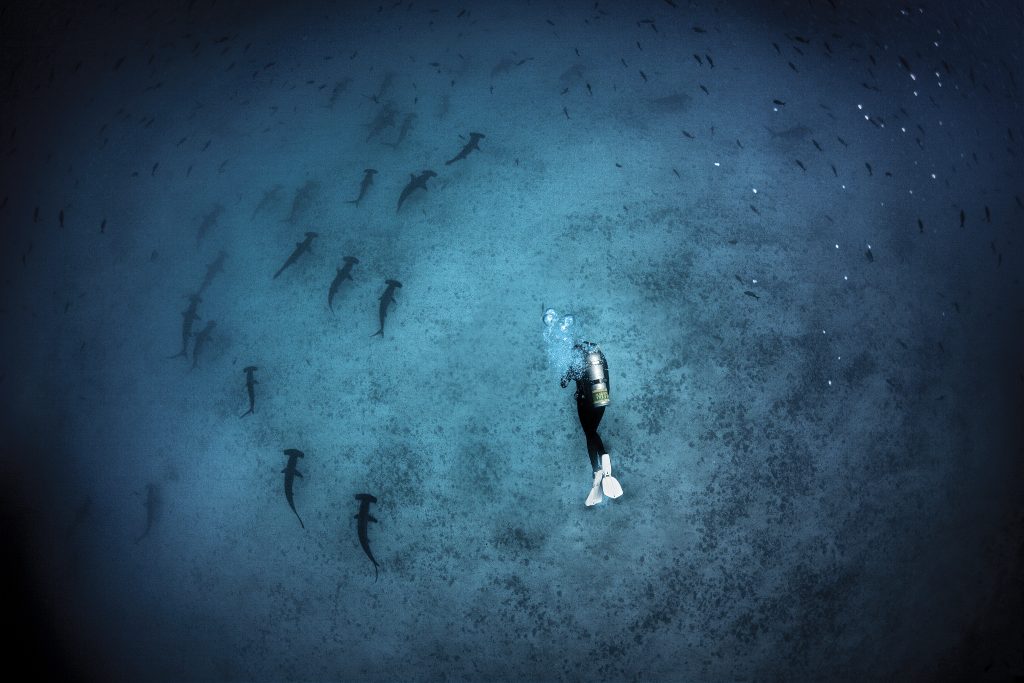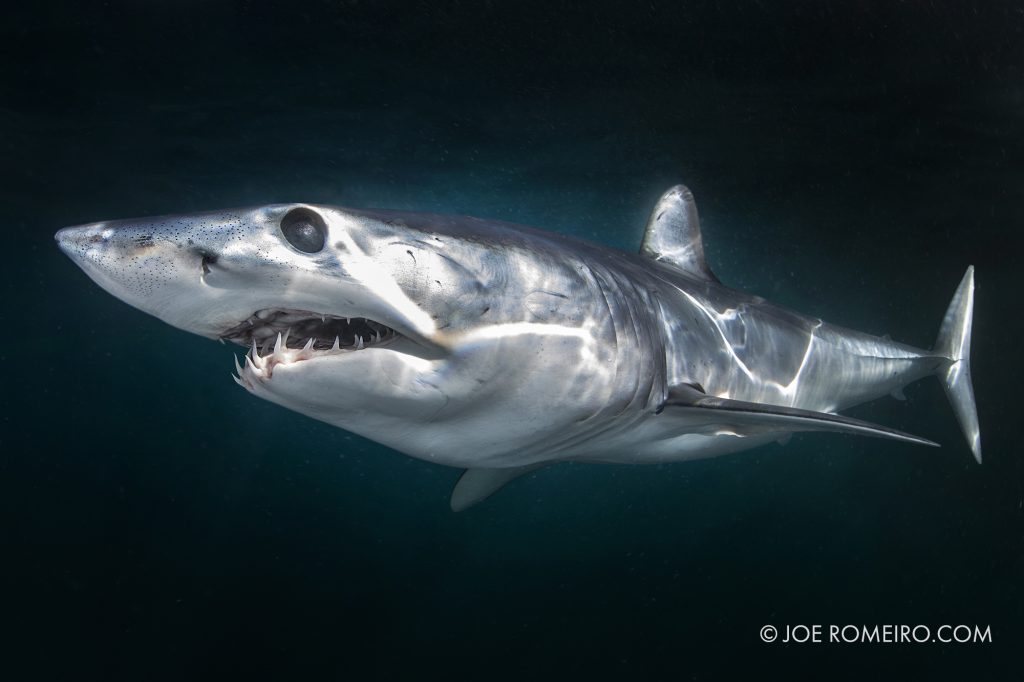Marine Life & Conservation Blogs
For PADI divers, every week is Shark Week!
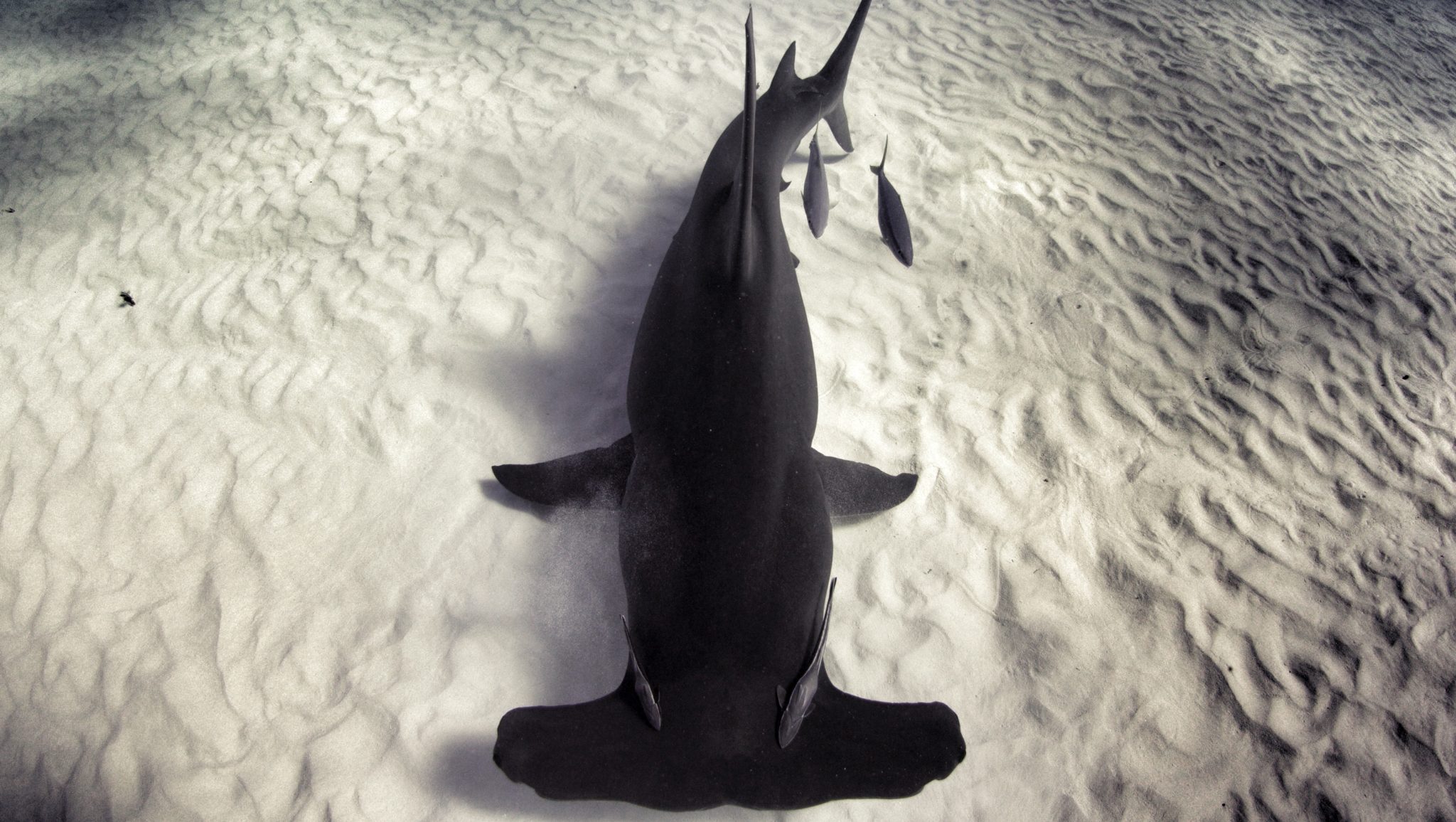
Some of our favorite places to have epic interactions with the stars of Shark Week – dive certification not always required!
We’ve been all around the world diving with sharks from the smallest shy shark to the giant whale shark. Here’s some of the best places in the world to swim, snorkel and dive with the iconic and most popular stars of Shark Week – including Whites, Bulls, Tigers, Great Hammerheads, and Mako Sharks – while shifting your perspective at the same time!
Great White Sharks – Guadalupe Island, Mexico
PADI Diving Certification required: None
Other Shark Species You’ll encounter: None (they don’t want to end up on the White Shark’s menu!)
Want to have the same experience people like PADI Diver Andy Casagrande film for Discovery’s Shark Week? Head to a remote archipelago off the coast of Baja.
Guadalupe Island is off the coast of Mexico and is absolutely epic for experiencing white sharks doing what they do best. This small volcanic island is located 150 miles off the west coast of Mexico and is home to approximately 170 great white sharks from July to November.
The water is crystal clear, topside conditions are usually great – and the action is incredible, and highly reliable. While we are dealing with wild animals that make their own itineraries, it isn’t unusual to see 20 – 30 different animals on a trip!
The island’s shores are havens for Guadalupe Fur Seals, Californian Sea Lions and Northern Elephant Seals. It also brings in incredible amounts of pelagic fish species like tuna. It’s a 24-hour diner filled with white sharks’ favorite food from late July through the end of each year.
Some of the biggest sharks in the world have been tagged in Guadalupe including “Deep Blue”. The action at the surface can be busy with the huge females hunting large elephant seals and from the in-water cages, it’s incredible to witness the social structures and the interaction between sharks.
Many operators serving Guadalupe Island offer the unique experience of liveaboard diving with great whites. While it may not be the easiest place to reach, thanks to the large population of migrating sharks and clarity of the water, this is a great choice for a great white shark encounter.
And you don’t need to be a certified diver! You’ll have surface supplied air and plenty of time in cages built for your – and the sharks’ safety.
Choose from 7 PADI Liveaboards in Guadalupe Island
Other White Shark Hotspots:
- Port Lincoln – Australia
- Gansbaii + False Bay, South Africa
- Farrallon Islands, California
- South Island, New Zealand
Tiger Sharks – “Tiger Beach”, Bahamas
PADI Diving Certification required: Open Water Diver or Freediver
Other Shark Species You’ll Encounter: lemon sharks, reef sharks, nurse sharks and the occasional great hammerhead
Named because of their unique stripes and impressive hunting style, tiger sharks can be found in tropical and sub-tropical regions around the globe. These beautiful marine animals can reach up to 5 meters/16 feet in length and can weigh up to 635 kg/1,400 lb.
Tiger sharks have gotten a bad reputation on Shark Week as being indiscriminate eaters (yes, it’s true a suit of armor and an unexploded grenade have been found in the stomachs of this species) – and dangerous sharks. However, swimming with one – whether snorkeling, freediving or diving is a life-changing experience. You’ll quickly realize that you are having an adventure of a lifetime as the fear melts away. And there is really no place on earth like this place off the coast of the Bahamas – that exists only below the surface.
About an hour by boat from the West End of Grand Bahama, Tiger Beach is famous and aptly named for its resident tiger sharks. Two to seventeen of these gorgeous animals reliably appear nearly every day of the year. Tiger Beach offers the chance to take part in some of the greatest shark diving in the world. You’ll get up-close encounters with not only tiger sharks but lemon sharks, the occasional hammerhead and plenty of whitetip reef sharks in the crystal-clear azure waters that only an aquarium can top in terms of visibility.
The best time to dive Tiger Beach is between October and January when the sharks use the area as a breeding ground. Shark Week has featured some of the residents being tagged or even giving birth – and hopefully you’ll even meet Emma, the world’s most famous Tiger Shark.
From Bimini or Grand Bahamas, you can head to the most spectacular tiger shark gatherings in the world by a day boat – or you can take a trip on a liveaboard departing from Southern Florida or the Bahamas. The easy surface conditions, 20-foot depth and gorgeous light make Tiger Beach accessible for freedivers and scuba divers alike.
View Dive Operators in the Bahamas
Other Tiger Shark Hotspots:
- Beqa Lagoon- Fiji
- Hawaii
- Aliwal Shoal – South Africa
- South Carolina – USA
Bull Sharks – Shark Reef, Fiji
PADI Diving Certification required: Advanced Open Water Diver
Other Shark Species You’ll Encounter: tiger sharks, gray reef sharks, nurse sharks, black tip reef sharks, silvertip sharks
Part of many different Shark Week episodes, bull sharks are well known sharks for many reasons – including a reputation for brutish behavior (which earns them their name) as well as the fact they are one of the most adaptable species of all sharks. They can survive in both salt and fresh water and can be found in most coastlines throughout the world. Although they’re portrayed as one of the more aggressive sharks on shark week, they are incredible creatures to see underwater and shouldn’t be missed. And there’s literally no better place to dive with bull sharks than Fiji – where you’ll find the biggest bull sharks in large numbers.
With the establishment of the Shark Reef Marine Reserve, Beqa Lagoon has become a premier shark diving area the world over. Bull sharks are the stars of the show here, but divers can encounter up to 7 other species as well. These include sickle lemons, gray reefs, nurse, blacktip reefs, whitetip reefs, silvertips and tiger sharks. With more than 20 dive sites in the lagoon, divers can fill a week or more with fantastic shark sightings. Although you will see sharks during any month of the year, July to September offer the best diving conditions in terms of visibility, water temperature and other large marine life.
As an added bonus, any diving done in the Shark Reef Marine Reserve finances shark research and compensates local fishermen for lost income due to the creation of no-take zones. It’s a win-win-win for sharks, divers and the local population!
A recent study in Fiji found that bull sharks form friendships with each other! Researchers studied data collected over 3,000 shark dives in Fiji’s Shark Reef Marine Reserve (SRMR), one of the world’s most sought-after diving destinations. SRMR is located in the Beqa Channel, off the southern coast of Viti Levu, and is a striking example of collaboration for conservation.
The shark is revered by local Fijians and legend has it that Dakuwaqa, the ancient shark god, provides protection for the people when at sea. So not only will you be exploring Fiji’s underwater world with your dive buddy, but you will likely encounter a pair of bull shark BFFs on your dive too!
View Dive Resorts in Beqa Lagoon
Other Bull Shark Hotspots:
- Bimini, Bahamas
- Playa del Carmem, Mexico
- West Palm Beach and Jupiter,Florida
- Protea Banks, South Africa
Great Hammerhead Sharks – Bimini, Bahamas
PADI Diving Certification required: Open Water Diver or Freediver
Other Shark Species You’ll Encounter: bull sharks, lemon sharks, reef sharks, nurse sharks and don’t forget the shark’s close cousin… the eagle ray
Bahamas makes it on our list twice thanks to the incredible conditions underwater (there’s actually a color named Bimini Blue), and the fact the Bahamas plays hosts to some of the most spectacular mega-fauna in the world – including the Great Hammerhead Shark.
There’s no mystery as to how the hammerhead shark got its name! That massive hammer – known as a cephalfoil – makes them one of the most distinctive animals on the planet. And that hammer isn’t just for show… It gives this shark superpowers which means the great hammerheads have seven finely attuned senses plus 360-degree vision (without turning their head!) to be able to avoid divers. Seeing a great hammerhead is rare as they tend to be quite skittish underwater, so finding a place you can reliably experience them is a rarity.
Every winter from December to March, great hammerhead Sharks gather around Bimini in large numbers. Naturally shy and reserved, these huge sharks with their odd faces become curious in this location, closely approaching divers. Shark diving is closely controlled due to the area’s marine park status. Although Bimini Island is a part of the Bahamas, it is located just 50 miles from Miami in the United States, making it possible to visit by boat in just three hours from the American city.
The waters of Bimini are warm, clear and typically protected. The shark dives occur in less than 20 feet of water allowing divers and freedivers to enjoy incredible encounters.
Plan a trip to Bimini to see the “hammers” and you’ll likely catch up with bull sharks, friendly dolphin pods, and graceful schools of eagle rays. You’ll feel like you stepped back in time to an island still not heavily commercially developed and traversed by golf carts. Bimini can be explored by divers and snorkelers alike – and is absolutely stunning above and below the surface. Head to nearby Honeymoon Beach to swim with the local group of rays as well – after all, rays are really just flat sharks!
Other Great Hammerhead Hotspots:
- Southern Florida, USA
- Rangiroa, French Polynesia
- Solomon Islands
Shortfin Mako Sharks – Rhode Island, USA
PADI Diving Certification required: None
Other Shark Species You’ll Encounter: blue sharks
Mako sharks get nearly as much airtime on Shark Week as white sharks, thanks to their incredible biology, although the fact they are in the same shark family as whites (mackerel) probably doesn’t hurt!
Shortfin mako sharks are sometimes described as miniature great whites on amphetamines. These toothy sharks look like a shrunken-down version of the ocean’s top predators, but they act totally differently. While great white sharks slice slow, graceful circles around a diver, watching with an inquisitive eye, makos are twitchy sharks, hopped up on adrenaline, that speed past you.
Thought to be the fastest sharks in the ocean, makos have an estimated top speed burst of about 45 mph. They can achieve these speeds thanks, in part, to their ability to thermoregulate – meaning they can warm their body temperatures. Incredible acrobats, like great whites, makos are known to jump out of the water, sometimes up to 20 feet in the air, using their perfectly shaped fins as wings and rudders.
Equally impressive, they have the largest brain to body mass of any study shark as well. So they have it all – beauty, brains and braun.
Makos are pelagic sharks that live throughout the world’s oceans, but there are only a handful of places where you can have reliable encounters with these incredible creatures. Our favorite, most reliable place? Rhode Island. Plus, you don’t even have to be a diver!
Most people don’t think of Rhode Island as a shark-diving hot spot, but during the summer months, when the Gulf Stream moves close to shore, this stretch of New England coastline becomes a haven for makos and other sharks, as game fish move closer to shore. You can even join PADI divers, PADI AWARE supporters and Shark Week celebrities Joe and Lauren Romiero as they film and study the local mako population on their dive charter.
Even if you miss the stars, the equally charismatic blue sharks steal the show.
Other Mako Hotspots:
- Baja Sur, Mexico
- Cape Point, South Africa
- San Diego, California
- Azores
Header Image Credit: Andy Casagrande @ABC4EXPLORE
Marine Life & Conservation Blogs
Creature Feature: Dusky Shark

 In this series, the Shark Trust will be sharing amazing facts about different species of sharks and what you can do to help protect them.
In this series, the Shark Trust will be sharing amazing facts about different species of sharks and what you can do to help protect them.
This month we’re taking a look at the Dusky Shark, a highly migratory species with a particularly slow growth rate and late age at maturity.
Dusky sharks are one of the largest species within the Carcharhinus genus, generally measuring 3 metres total length but able to reach up to 4.2 metres. They are grey to grey-brown on their dorsal side and their fins usually have dusky margins, with the darkest tips on the caudal fin.
Dusky Sharks can often be confused with other species of the Carcharhinus genus, particularly the Galapagos Shark (Carcharhinus galapagensis). They have very similar external morphology, so it can be easier to ID to species level by taking location into account as the two species occupy very different ecological niches – Galapagos Sharks prefer offshore seamounts and islets, whilst duskies prefer continental margins.
Hybridisation:
A 2019 study found that Dusky Sharks are hybridising with Galapagos Sharks on the Eastern Tropical Pacific (Pazmiño et al., 2019). Hybridisation is when an animal breeds with an individual of another species to produce offspring (a hybrid). Hybrids are often infertile, but this study found that the hybrids were able to produce second generation hybrids!
Long distance swimmers:
Dusky sharks are highly mobile species, undertaking long migrations to stay in warm waters throughout the winter. In the Northern Hemisphere, they head towards the poles in the summer and return southwards towards the equator in winter. The longest distance recorded was 2000 nautical miles!
Very slow to mature and reproduce:
The Dusky Shark are both targeted and caught as bycatch globally. We already know that elasmobranchs are inherently slow reproducers which means that they are heavily impacted by overfishing; it takes them so long to recover that they cannot keep up with the rate at which they are being fished. Dusky Sharks are particularly slow to reproduce – females are only ready to start breeding at roughly 20 years old, their gestation periods can last up to 22 months, and they only give birth every two to three years. This makes duskies one of the most vulnerable of all shark species.
The Dusky Shark is now listed on Appendix II of the Convention on the Conservation of Migratory Species (CMS), but further action is required to protect this important species.
Scientific Name: Carcharhinus obscurus
Family: Carcharhinidae
Maximum Size: 420cm (Total Length)
Diet: Bony fishes, cephalopods, can also eat crustaceans, and small sharks, skates and rays
Distribution: Patchy distribution in tropical and warm temperate seas; Atlantic, Indo-Pacific and Mediterranean.
Habitat: Ranges from inshore waters out to the edge of the continental shelf.
Conservation status: Endangered.
For more great shark information and conservation visit the Shark Trust Website
Images: Andy Murch
Diana A. Pazmiño, Lynne van Herderden, Colin A. Simpfendorfer, Claudia Junge, Stephen C. Donnellan, E. Mauricio Hoyos-Padilla, Clinton A.J. Duffy, Charlie Huveneers, Bronwyn M. Gillanders, Paul A. Butcher, Gregory E. Maes. (2019). Introgressive hybridisation between two widespread sharks in the east Pacific region, Molecular Phylogenetics and Evolution 136(119-127), https://doi.org/10.1016/j.ympev.2019.04.013.
Marine Life & Conservation Blogs
Creature Feature: Undulate Ray

 In this series, the Shark Trust will be sharing amazing facts about different species of sharks and what you can do to help protect them.
In this series, the Shark Trust will be sharing amazing facts about different species of sharks and what you can do to help protect them.
This month we’re looking at the Undulate Ray. Easily identified by its beautiful, ornate pattern, the Undulate Ray gets its name from the undulating patterns of lines and spots on its dorsal side.
This skate is usually found on sandy or muddy sea floors, down to about 200 m deep, although it is more commonly found shallower. They can grow up to 90 cm total length. Depending on the size of the individual, their diet can range from shrimps to crabs.
Although sometimes called the Undulate Ray, this is actually a species of skate, meaning that, as all true skates do, they lay eggs. The eggs are contained in keratin eggcases – the same material that our hair and nails are made up of! These eggcases are also commonly called mermaid’s purses and can be found washed up on beaches all around the UK. If you find one, be sure to take a picture and upload your find to the Great Eggcase Hunt – the Shark Trust’s flagship citizen science project.
It is worth noting that on the south coasts, these eggcases can be confused with those of the Spotted Ray, especially as they look very similar and the ranges overlap, so we sometimes informally refer to them as ‘Spundulates’.
Scientific Name: Raja undulata
Family: Rajidae
Maximum Size: 90cm (total length)
Diet: shrimps and crabs
Distribution: found around the eastern Atlantic and in the Mediterranean Sea.
Habitat: shelf waters down to 200m deep.
Conservation Status : As a commercially exploited species, the Undulate Ray is a recovering species in some areas. The good thing is that they have some of the most comprehensive management measures of almost any elasmobranch species, with both minimum and maximum landing sizes as well as a closed season. Additionally, targeting is entirely prohibited in some areas. They are also often caught as bycatch in various fisheries – in some areas they can be landed whilst in others they must be discarded.
IUCN Red List Status: Endangered
For more great shark information and conservation visit the Shark Trust Website
Image Credits: Banner – Sheila Openshaw; Illustration – Marc Dando
-

 News3 months ago
News3 months agoHone your underwater photography skills with Alphamarine Photography at Red Sea Diving Safari in March
-

 News3 months ago
News3 months agoCapturing Critters in Lembeh Underwater Photography Workshop 2024: Event Roundup
-

 Marine Life & Conservation Blogs3 months ago
Marine Life & Conservation Blogs3 months agoCreature Feature: Swell Sharks
-

 Blogs2 months ago
Blogs2 months agoMurex Resorts: Passport to Paradise!
-

 Blogs2 months ago
Blogs2 months agoDiver Discovering Whale Skeletons Beneath Ice Judged World’s Best Underwater Photograph
-

 Marine Life & Conservation2 months ago
Marine Life & Conservation2 months agoSave the Manatee Club launches brand new webcams at Silver Springs State Park, Florida
-

 Gear Reviews3 months ago
Gear Reviews3 months agoGear Review: Oceanic+ Dive Housing for iPhone
-

 Gear Reviews2 weeks ago
Gear Reviews2 weeks agoGEAR REVIEW – Revolutionising Diving Comfort: The Sharkskin T2 Chillproof Suit


